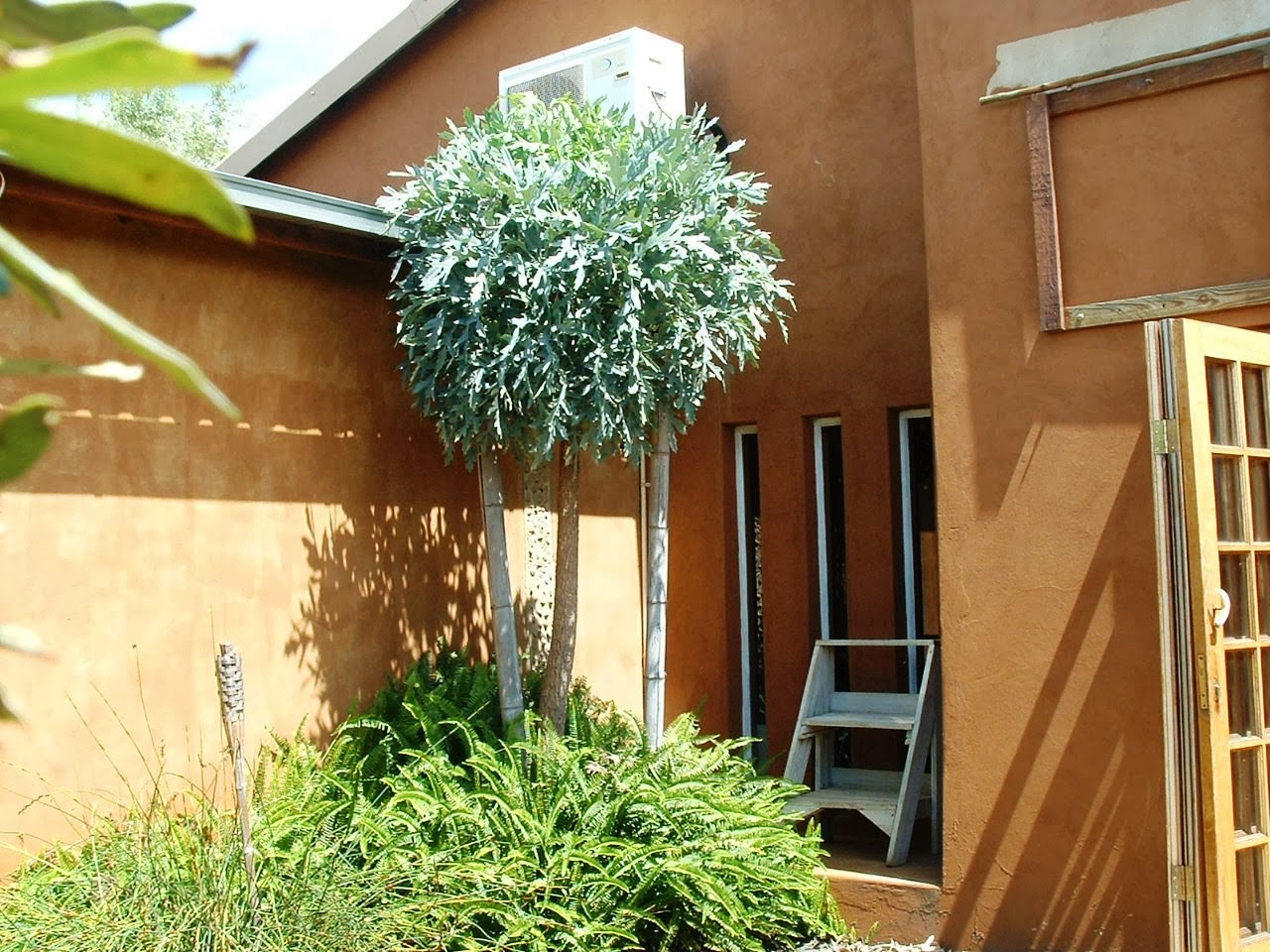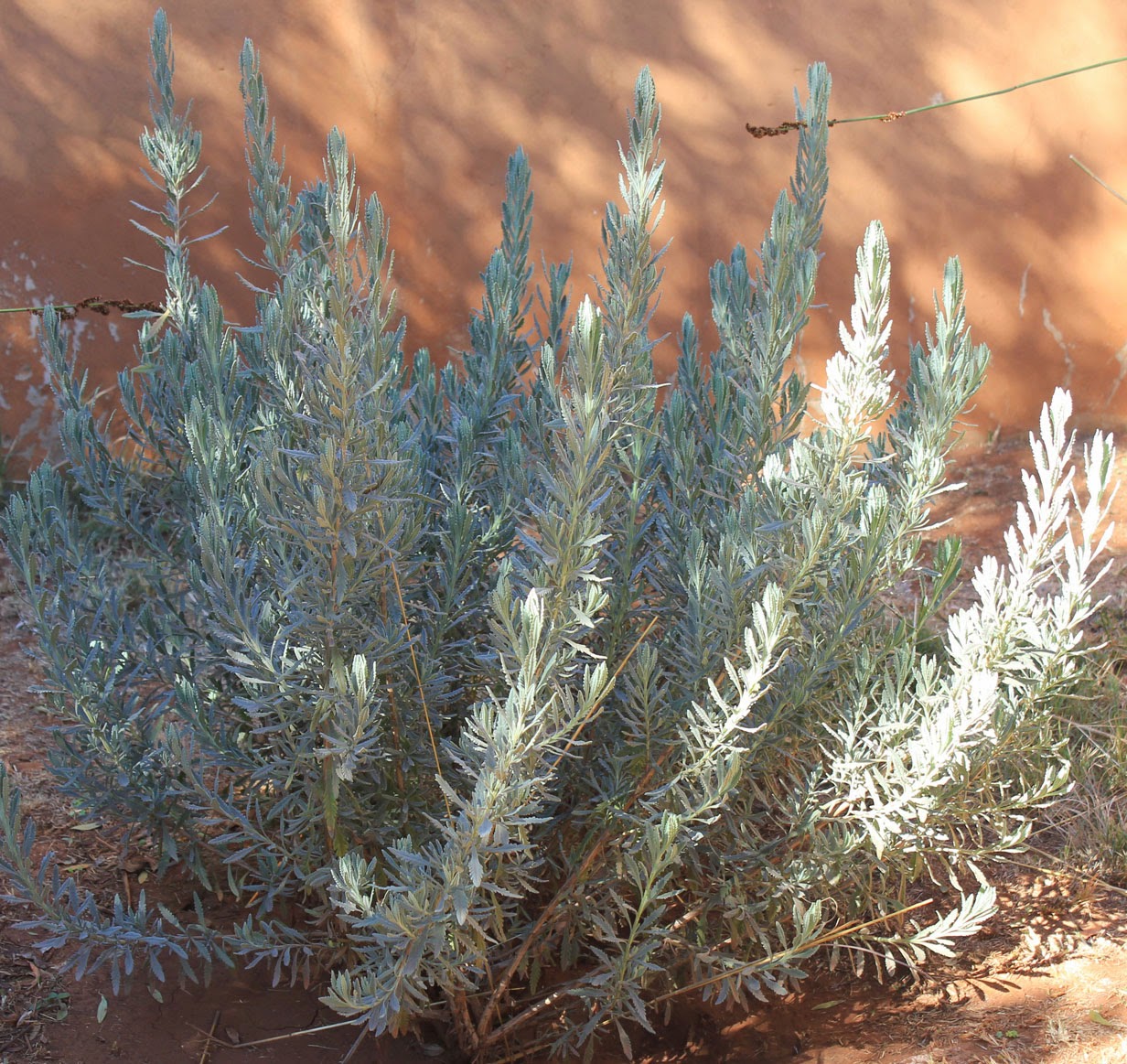Trees are beautiful in their peace, they are wise in their silence. They will stand after we are dust. They teach us, and we tend them.
- Galeain ip Altiem MacDunelmor
The Kiepersol in my bathroom court-yard garden
The Highveld Cabbage Tree (Cussonia
paniculata) is an evergreen tree that grows up to 4m tall. The Common Cabbage tree has long grey stems with smooth bark. Flowers from April to May and fruits from June to September.
This evergreen tree makes a beautiful focal point in a garden as it has an unusual shape, interesting gnarled bark and stunning, large, grey-green leaves. Plants show up especially well in a layout where rocks are used. Gardeners growing indigenous South African plants favour them greatly for their unique appearance. The wood is soft and light and was used for the brake-blocks of wagons. The leaves provide good fodder for stock and the Zulu name refers to this tree as goats' food. The roots are succulent and edible, mashed roots have also been used in the treatment of Malaria. It is a short, thick-set tree, rarely exceeding 5 meters in height, therefore making a perfect garden specimen. Even though it is an evergreen, we live in a heavy frost area and my tree loses its leaves in winter, but has always bounced right back every spring.
Afrikaans Name: Berg Kiepersol
Zulu Name : Umsengembuzi
Cussonia
paniculata is native to Southern Africa (Botswana, Lesotho, South Africa (Cape Provinces, Northern Provinces, KwaZulu-Natal) and Swaziland) and occurs inland at altitudes up to 2 100 m. It is often found in rocky places from the mountains of the Karoo and Eastern Cape through KwaZulu-Natal and Free State into Gauteng and further north. It grows in crevices filled with natural organic humus and compost. It is commonly found near Johannesburg and Pretoria. It is frost-tolerant and drought resistant
Uses:
Leaves are browsed by Kudu and domestic stock. Baboons eat the young shoots. Ripe fruit is eaten by Bulbuls, Louries, Starlings, Barbets and Mousebirds.
Medicinal Uses:
Decoctions are used to treat madness, convulsions, amenorrhoea, heart pains, venereal disease and pains of the uterus.
Mountain Cabbage tree - Cussonia paniculata subsp. paniculata
There are two subspecies of Cussonia paniculata. The smaller Mountain Cabbage tree C. paniculata subsp. paniculata has leaflets without lobes and has a limited distribution in Eastern Cape (see pic above) and rarely exceeds a height of 3m. C. paniculata subsp. sinuata forms a larger tree with deeply lobed leaves and is more widespread. This is the form more commonly found in cultivation and the one I have in my garden. They can grow up to 15-20 ft. (4.7-6 m).
Cussonias belong to a large family Araliaceae, which include Ginseng, Ivy, and several indoor plants. It is also closely related to the parsley family (Apiacae) which includes several popular vegetables and herbs such as carrots, fennel and parsley.
Growing Cussonia paniculataThe best method of propagation is by means of seed harvested from fresh ripe fruits. Sow seed as soon as possible as it loses much of its viability within 3 months. However, seed sown in summer months will germinate faster (in about 4 weeks) than seed sown in winter (7 weeks to germination). Make sure seed trays are at least 15 cm in depth to allow the small tubers to form. Do not allow seed to become waterlogged or dry out.
Keep seed and seedlings in a semi-shaded area. Seedlings can be transplanted at about 4 months, but be very careful not to damage the fleshy roots when transplanting. The seeds should be planted in a well-drained mix of river sand and compost (70:30). Cover the seeds to a depth of 5mm with the soil and mulch. Keep moist during germination. First germination occurs after about 2 weeks.
When the seedlings get to a “2-leaf” stage (about 4 months), plant them out into larger black nursery bags or plastic pots.
When ready to plant the sapling into the ground, remember that this tree needs well-drained soil, some water and lots of sun. Once you've chosen your spot, position a 50 mm size x 1m length of plastic piping vertically near to the sapling, leaving +- 10cm above ground level. When watering around the sapling, also pour water into this pipe, as it will encourage the roots to grow downwards looking for the moisture below. Keep the ground around the sapling well mulched with dry leaves etc to assist with water retention above ground.
The C. paniculata is an ideal pot plant (plant it in a big pot in a well drained mix), or can be planted as a single specimen or in a cluster - the effect is always striking.
Growth rate is about 70cm per year, depending on the climate. The tree is drought hardy and is able to withstand heavy frost after 2 years. One can grow Cussonia paniculata from a cutting, but this is not advisable because it does not make the proper, fleshy, underground rootstock that it forms when grown from seed.
Cussonia spicata (Natal cabbage tree, 5m) is a shapely tree with the same interesting foliage as the Highveld version. In summer, green flowers are borne that look like 20cm long candles.
April 2012
Even though most websites say the Cabbage Tree is an evergreen tree, that has not been the case with mine here in Tarlton (Gauteng, South Africa). Above is my Kiepersol in April, just before the winter, and below is my Kiepersol at the beginning of Spring - it was completely bare, looking almost dead, but now sprouting new leaves and heads.
Sept 2012
Over the years it has changed from a single head to four or five, each consecutive winter frost taking its toll. Below you can see a new head forming on an old branch.
I planted my 50cm little Kiepersol in 2006 and within a year it had doubled in size. Two years later, in 2009, it had doubled in size again, growing to an impressive 3m within three years.
2006
2009
November 2011
These trees make a beautiful focal point with their attractive gnarled trunk and grey leaf. So if you have a spare sunny spot in your garden, consider getting one or two of these. They are actually shown off at their best in a rock and large boulder garden.
.








































































































